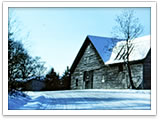
|
Follow Me On: |
 |
Kathleen Petty AVP/Sr Mortgage Originator Global Credit Union Home Loans AK#157293 Phone: (907)261-3458 Cell: 223-4440 Fax: (907)929-6699 License: NMLS Unique Identifier #203077 K.Petty@gcuhome.com https://www.globalcu.org/home-loans/resources/originators/Kathleen-Petty/ |
 | ||
| ||||
October 2006

|
Winterizing Your Home An Ounce of Prevention Will Pay Dividends
Winter is a time of year that many homeowners dread. For most, the trepidation begins during Fall as thoughts of inclement weather begin to surface, along with concerns about the potential damage it may cause. Here at YOU Magazine, we say, "fear not!" By providing you with a checklist for "winterizing" your home, we hope to save you from much of this needless angst. Before we get started, it's important to note that every suggestion in this article will not apply to every homeowner. We live in a big country, complete with varying weather conditions. Our goal is to try to address them all. So, if something doesn't apply to your particular region, simply move on to the next tip! Let's get started. The Roof We'd like to remind you that climbing on your roof is a potentially dangerous feat that may be best accomplished by a professional roofer. You may wish to contact your loan professional for a list of qualified roofers in your area. If you do decide to inspect the roof yourself, use caution and start by inspecting the shingles or tiles which lay on top. If anything is loose, curled, split, or overly worn, you'll want to have it replaced. This is how roof deterioration starts, so dealing with it now could save thousands of dollars in the long run. If you fear that your roof is in bad shape prior to inspection, walking on it may damage it further. In this case, use binoculars to view the roof from a safe vantage point such as a secured ladder. Take a look at the chimney. You're primarily searching for any loose masonry or large cracks. You'll then want to inspect the "flashing" or sealant around the base of your chimney for lifting or cracking. You'll also want to make sure that your chimney still has its screen and cap securely attached. If you notice problems with any of these areas, contact a chimney repair specialist in your area. A specialist will also be able to inspect the interior of your chimney, as well as clear it of any nests or debris. Inspect the gutters which line the perimeter of your roof. If they're in need of cleaning, then you should definitely do so, or hire someone to do it for you. Once the gutters are cleaned, it's recommended that you run water through the down spouts to make sure that there are no clogs or leaks. Also, be sure to observe how the water drains out. This should occur at least several feet from your home. Before you leave the roof, take a quick look around to see if there are any tree limbs, whether they're yours or your neighbors, which hang over your roof or close to power lines. If the limbs encroach on power lines, your local power company may just trim them back free of charge. The Outside of Your House & Your Yard If you live in an area with high moisture, you'll want to apply an additional coat of sealant to wooden decks. Chances are the summer sun has caused deterioration to the deck's protective layer, and re-sealing it will ensure that the wood won't absorb an excessive amount of water. If your area experiences extremely low temperatures, sealing any cracks in your driveway or sidewalk is also a good idea. If you have outdoor furniture or a barbecue, you'll want to cover them up or store them in the garage. In terms of the shrubbery around the outside of your home, two precautionary steps will greatly improve the way it will look once winter has lifted. First, prune away any weeds or dead foliage from the base of each shrub. Next, add a layer of mulch to the surrounding ground, especially to any perennial flower beds. Once you've tended to the greenery, you may want to winterize your power equipment. Fall is the perfect time for draining gas from lawn mowers and oiling any power tools. You'll also want to drain garden hoses, roll them up, and store them in the garage. If you want to take extra precautions, drain your outdoor faucets and cut off the water. This will keep pipes from freezing and eventually bursting. If you live in an area where it snows, do yourself a favor and make sure your snow removal equipment is in proper working order. In terms of a home's exterior, the key word to keep in mind is "leaks". Leaks not only allow cold air to enter your home but water as well. Start by inspecting the home's foundation and exterior walls. Minor cracks can usually be sealed by using a caulk that's appropriate for the temperature of your region. Special attention should be paid to the wall area around windows and outdoor faucets. Also, if you have storm windows, now is the time to install them. The Great Indoors Regardless of the type of heating system you have, it's a good idea to have it checked and maintained by a professional. Clean ducts and filter replacements can go a long way when it comes to improving efficiency. Also, be sure to clean and vacuum any heating vents, and keep the flue or damper closed when your fireplace is not in use. As far as plumbing is concerned, every homeowner should periodically check their hot water heater for leaks, no matter where they live. This is the last thing you'll want to repair during the cold months. You may also want to consider purchasing a hot water heater blanket. It's a $15 investment that will increase the heater's efficiency. If you live in an area known for very cold weather, you may have a problem with pipes freezing. This can be alleviated by wrapping the pipes that are most prone to freezing with heat tape which can be purchased at any hardware store. Lastly, if you've experienced serious weather issues in past years, you may want to prepare a comprehensive emergency kit for your home. It never hurts to be prepared. Good luck, and have a happy and safe winter! | ||||||||||||||||||||||||||||||
License #AK157293 You are receiving a complimentary subscription to YOU Magazine as a result of your ongoing business relationship with Kathleen Petty. While beneficial to a wide audience, this information is also commercial in nature and it may contain advertising materials. INVITE A FRIEND to receive YOU Magazine. Please feel free to invite your friends and colleagues to subscribe. SUBSCRIBE to YOU Magazine. If you received this message from a friend, you can subscribe online. UNSUBSCRIBE: If you would like to stop receiving emails from Kathleen Petty, you can easily unsubscribe. Global Credit Union Home Loans AK#157293 |
, 125 W Dimond Blvd #110 Anchorage, AK 99515 Powered by Platinum Marketing © Copyright 2024. Vantage Production, LLC. | |||||||||


